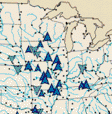 Stream Water Quality in the Conterminous United States --
Status and Trends of Selected Indicators During the 1980's
Stream Water Quality in the Conterminous United States --
Status and Trends of Selected Indicators During the 1980's
 Stream Water Quality in the Conterminous United States --
Status and Trends of Selected Indicators During the 1980's
Stream Water Quality in the Conterminous United States --
Status and Trends of Selected Indicators During the 1980's
Go to Table of Contents
or Go back to previous section
The most abundant data for describing national stream water-quality conditions and trends are traditional sanitary and chemical water-quality indicators such as dissolved oxygen, fecal coliform bacteria, nutrients (nitrate and total phosphorus), and suspended sediment. Concentrations of several of these water-quality indicators decreased during the 1980's and, collectively, provide evidence of progress in pollution control during the decade. The most notable improvements occurred in concentrations of fecal coliform bacteria, an important indicator of the suitability of stream water for contact recreation, and total phosphorus, which usually is the nutrient controlling the process of eutrophication in freshwater. Nationally, the percentage of water-quality monitoring stations having fecal coliform bacteria and total phosphorus concentrations greater than desirable limits decreased substantially during the 1980's. Widespread declines also occurred in the load of total phosphorus transported to large reservoirs and coastal waters, where the accumulation of phosphorus can lead to persistent eutrophication problems. However, despite widespread declines in these indicators, more than a third of the streams sampled in 1989 had annual average concentrations of total phosphorus and fecal coliform bacteria that exceeded desirable limits. Thus, water-quality goals are not yet being met in a significant percentage of streams.
Trends in other traditional indicators provide evidence of slight improvement or little change in stream water quality during a decade when the economy and population showed significant growth. For example, dissolved-oxygen concentrations nationally changed little from 1980 to 1989, but streams in urban areas showed slight improvement in dissolved-oxygen conditions, possibly reflecting the effect of improving point-source controls. Similarly, nitrate concentrations and yields remained nearly constant nationally, but they declined in a number of streams draining agricultural areas where nitrate levels have been historically high. This general tendency toward constant or declining nitrate concentrations represents a significant departure from the pattern of trends for 1974-81, when widespread increases in nitrate were reported. Also, the quantity of nitrate transported to coastal waters, where nitrogen plays an important role in eutrophication, decreased in the Gulf of Mexico area but increased somewhat in the North Atlantic and California coastal segments during the 1980's. Suspended- sediment concentrations and yields decreased slightly in most of the country, and the quantity of suspended sediment transported to coastal segments decreased or remained the same in all but the North Atlantic region. Finally, little change was noted in the concentrations of most major dissolved constituents that have economic significance through their effects on the esthetic characteristics of drinking water, the chemical characteristics of industrial process water, or the salinity of irrigation water. Annual average concentrations of dissolved constituents exceeded desirable limits at a third or fewer of the streams sampled for each constituent. The most noteworthy changes were substantial decreases in the chemical corrosivity of stream water used for domestic and industrial water supplies.
National-level information documenting trends in the toxicological aspects of water quality is limited to data on toxic contaminants in finfish tissue in major rivers and the Great Lakes compiled by the FWS between 1970 and 1986. Contaminant concentrations in finfish tissue are integrative measures of water quality and can reflect long-term average contaminant concentrations in stream water and sediment. The data show that since the 1970's, concentrations of the toxic elements arsenic, cadmium, and lead and the organic compounds chlordane (and related compounds), dieldrin, DDT (and related compounds), toxaphene, and total PCB's declined significantly. However, the concentrations of mercury remained nearly constant during the time period.
Although national-level information on trends in pesticides in stream water is not available, recent studies of herbicide concentrations in streams in agricultural areas of the midwestern United States from 1989 to 1991 provide important regional information on the magnitude and distribution of herbicides in streams. These studies show that, during the first runoff in 1989 following herbicide application, atrazine exceeded applicable EPA drinking-water criteria at 52 percent of the streams sampled; for alachlor, cyanazine, and simazine, the number of streams sampled that exceeded the criteria ranged from 2 to 49 percent. Substantially lower, but detectable, concentrations of these herbicides persisted throughout the year in many of the streams in the region. Additional sampling for these herbicides in the Mississippi River and its major tributaries showed that alachlor and atrazine occasionally exceeded EPA drinking-water criteria and that substantial quantities of these herbicides are transported by major rivers over long distances.
In sum, stream water quality in the conterminous United States either improved or remained about the same during the 1980's as shown by most available measures. Although modest improvements in water quality during this period of economic growth represent a significant achievement in pollution control, much remains to be done to reach existing water-quality goals for the indicators currently monitored at the national level. Moreover, the fragmentary nature of data on the biological and toxicological aspects of stream water quality leaves largely unanswered the question of progress in these areas. Recently initiated Federal monitoring programs eventually will provide data for a more comprehensive view of water-quality conditions and trends that will show whether there is continued progress towards national water-quality goals.